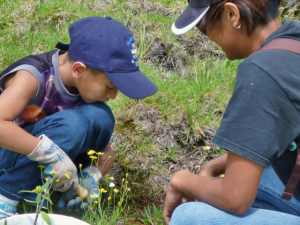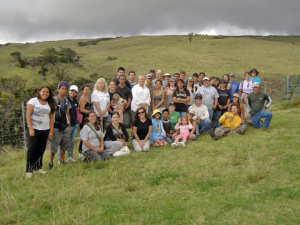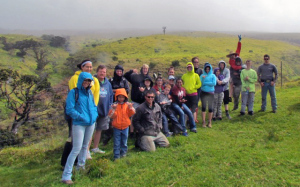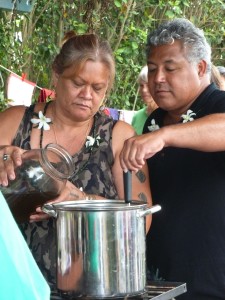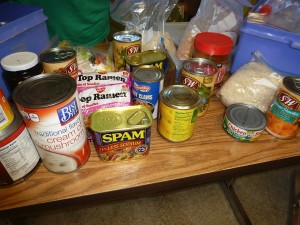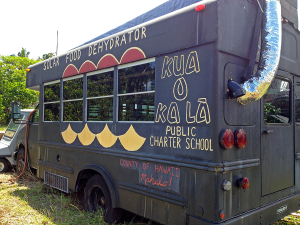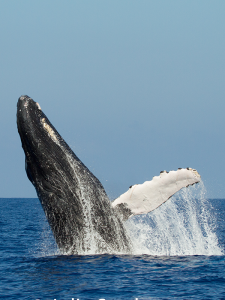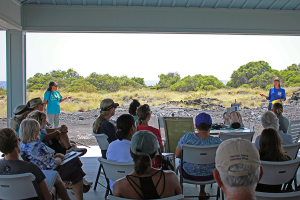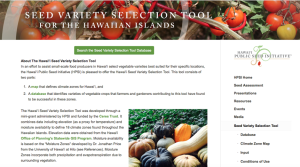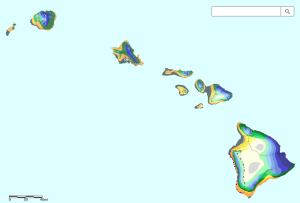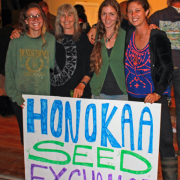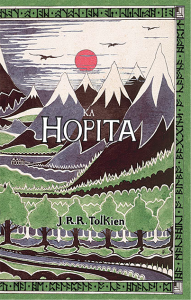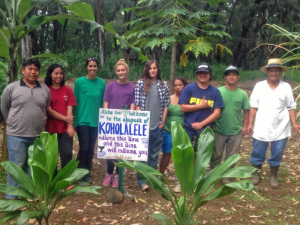Six years of Earth Day planting on Kohala Mountain yields a growing forest
If you’ve ever wondered whether volunteering a few hours on Earth Day actually makes a difference, look no further than Kohala Mountain. Every Earth Day since 2009, our Kohala Watershed Partnership (KWP) has invited volunteers for a day of tree planting in the Koai‘a Corridor. After six years, the results are visible, validating, and inspiring.
- Growing a forest…one baby tree at a time.
KWP offers volunteer opportunities nearly every other weekend, but its Earth Day event attracts the largest turnout of the year by far. Around 40 children and adults—ranging from ages 10 to 70—commemorate Earth Day with KWP by getting their hands dirty and planting a wide variety of native trees. The Koai‘a Corridor, a restoration site located just mauka (upland) of the Koai‘a Tree Sanctuary, was chosen as the volunteer site for KWP’s first Earth Day event mainly because of its accessibility, offering the perfect place for a large group of tree-planters. Today, the location is significant for another reason: the growing trees and greener landscape are a visible testament to the difference volunteers have made. According to Melora Purell, KWP coordinator, “the pictures we take each year have become a valuable way to document the site. We love being able to show our volunteers the result of their hard work over the years. It’s exciting and gratifying.”
In the early 2000s, a few key Hawai‘i Island staff of the Hawai‘i Department of Land and Natural Resources’ Natural Area Reserve System (NARS) developed a plan to connect the Koai‘a Tree Sanctuary to the Pu‘u O ‘Umi NAR located in the uplands of Kohala Mountain. Their vision was to reforest this swath of non-native grassy pasture along two perennial streams on the mountain’s leeward slope. The Koai‘a Corridor fence was completed in 2008 through collaboration between KWP and NARS staff on both public land and private properties of KWP partners. Planting in the 300-plus-acre enclosure began the same year.
- Volunteer crew from Earth Day 2011. The restoration area still looks like a pasture in the background.
The Koai‘a Corridor’s elevation gradient is accompanied by a pretty significant rainfall gradient. For reference, the coastal portion of Kohala receives an estimated five inches of rain a year, while the peak of Kohala receives close to 200 inches per year including fog drip, an important water source for upland trees. This precipitation gradient is what sets the Koai‘a Corridor apart from other restoration sites. “We plant such a range of trees in the corridor because of the variation in precipitation,” Purell explained. “There are over 50 different species of native trees and shrubs planted here. It’s pretty amazing to have a place with that much diversity accessible to our volunteers.”
Participants who plant in the lower elevations can expect to work with trees like koai‘a and māmane while wet-forest trees such as ‘olapa, ‘ōhiʻa, and pilo are planted at higher elevations. Conditions can be harsh for young trees in this deforested site due to strong winds and direct sunlight, competition with alien grasses, and compacted soil from over a century of cattle grazing. KWP and its partners approach reforestation in this challenging environment with a unique strategy that involves taking cues from the trees themselves. “We can plant a thousand trees out there and anticipate 600 of them to survive. We don’t baby the trees. Those pioneer plants that are tough enough to survive on their own are the ones we want in the preserve,” Purell said. The growing trees eventually improve the environment by producing leaf litter, shading out non-native grasses, and helping water infiltrate deeper into the soil through their roots.
- Volunteers braved a cold, wet planting day for Earth Day 2014. For the first time, the trees are beginning to be visible, poking out from the deep grass in the restoration area.
Eventually, trees that require shade and wind protection will be planted under the growing forest canopy of the pioneer species. “The plants change the system in ways people cannot. We have to rely on them to convert pasture into forest,” Purell said. “Essentially, we plant as many trees and as many different species as possible, and then let Mother Nature take her course.”
The very first Earth Day was celebrated in 1970 and is considered by many as the birth of the mainstream environmental movement. KWP is honored to have such large groups join them every year in the Koai‘a Corridor for their celebration. In addition to planting trees, the groups also take time to publicly recognize long-time volunteers for their contributions. It’s a joyful event filled with good conversations, hard work, and plenty of laughter. Like Purell says, “What better way and what better place to honor our connection with the Earth than Kohala Mountain?”
This year’s KWP Earth Day tree-planting event will be held on Saturday, April 25 from 8:30 a.m. to 3:30 p.m. Reservations are required and fill up fast. For more information about participating in the volunteer day or supporting KWP’s reforestation effort, please email coordinator@kohalawatershed.org.
School gardens bring taste of home to Mālama Honua voyage
Pondering the final leg of the Mālama Honua Worldwide Voyage of Hōkūle‘a and Hikianalia, Pwo (master navigator) Chadd Paishon expressed a novel idea: what if a majority of the food onboard Makaliʻi, when it sails to the South Pacific in 2017 to accompany Hōkūle‘a home, was actually grown and produced in Hawai‘i?
That got Amanda Rieux, program director at Māla‘ai: The Culinary Garden of Waimea Middle School, thinking about how school garden programs in Hawai‘i could not only supply food for the voyage, but also connect keiki (children) with the Polynesian Voyaging Society’s effort to circumnavigate the globe to raise awareness about sustainability. She approached Nancy Redfeather, director of our Hawai‘i Island School Garden Network, about motivating island students and teachers to support the voyage by growing and preparing healthy, local food products.
- Ka‘iulani Odom (left) and Kealoha Hoe prepare a stew as part of an ‘Ai Pono workshop held at Māla‘ai: The Culinary Garden of Waimea Middle School.
“This was a chance for our keiki to be a part of the Mālama Honua voyage,” Redfeather said. “It’s a natural fit with the school gardens because it brings home the idea that when we care for the Earth in sustainable ways, the Earth cares for us by providing the foods we need to live.”
Through Hau‘oli Mau Loa Foundation’s Hope for Kids initiative, Redfeather became acquainted with Ka‘iulani Odom, a cultural nutritionist at Kōkua Kalihi Valley in Honolulu who has provided dietary advice and ideas to the wa‘a (voyaging canoe) crews since 1995. Odom has advocated for increasing voyage foods grown and produced here at home, but recognizes that preservation and on-board preparation can be challenging. Such challenges, however, can provide meaningful, real-world learning opportunities for Hawai‘i’s students.
“This is not an overnight process, and as we experiment not every innovative idea will work,” Odom said. “But when communities and schools get excited about growing and preparing healthy and safe foods for the voyagers, they can be part of the voyage even if they’ve never sailed.”
Inspired by the ‘Ai Pono (healthy eating) work of Hōkūle‘a crew member Kealoha Hoe, his father Herbert Hoe, and their ‘ohana (family), Rieux, Redfeather, Kealoha Hoe, and Odom developed a series of ‘Ai Pono workshops and events to teach educators and community members about the cultivation and preparation of foods appropriate for long stretches at sea. The values of ‘Ai Pono emphasize more than just physical nourishment: foods are intended to provide mental, spiritual, and emotional replenishment as well. ‘Ai Pono curriculum introduces participants to the staple ingredients in the traditional Hawaiian diet such as ‘uala (sweet potatoes), kalo (taro), and poi; plants that can be used to make teas and condiments; and even covers essential skills required for voyage preparations, such as the making of cordage from plant fibers.
- An example of foods found in a typical “day box” onboard the wa‘a. Selected for their longevity, they do not provide crews with optimal nutrition nor a connection to their island homes.
“When Ka‘iulani and Pomai [Bertelmann from Nā Kālai Wa‘a] brought an example of a typical ‘day box’ to our first ‘Ai Pono workshop, and we all saw it full of cans of SPAM and Vienna sausage, I truly understood the challenge at hand,” Rieux said. “But the creative juices also started flowing, and participants got excited about working with their students to come up with solutions by experimenting with different crops and preparation methods to see what they could develop.”
Another ‘Ai Pono workshop, led by artist and craftsman Gary Eoff, focused on creating cordage for gifts to be presented along the voyage. Eoff conducted workshops with teachers and later helped students refine their traditional hāwele (tying or binding without knots) technique to make two-ply cordage from hau (Hibiscus tiliaceus). In addition to the actual tying, students gather the hau, ferment and soften the fibers in a month-long retting process, and clean and dry the fibers. “We place pieces of cordage inside small ipu (dried gourds) for the voyagers to use as cultural gifts around the world,” Eoff explains. “The cordage gifts tie people and communities together and put the kids on the voyage.” Eoff is also helping students with the packaging of their voyage foods, ensuring they are secure and properly labeled so they can clear customs at various ports.
Currently, several school garden programs on Hawai‘i Island are engaging their students in hands-on ways to support the Mālama Honua voyage:
- At Kamehameha Schools in Kea‘au, middle-school science teacher Rod Floro’s students are cultivating 25 different varieties of kalo to determine which grow best and will have the longest shelf life on the voyage. Floro’s students are also growing stevia and herbs to combine into teas—so far mamaki, koʻokoʻolau, and lemongrass are the favored combination—and growing medicinal herbs from many different cultures in hopes of making balms and salves for the crew.
- Ninth- and tenth-grade students at West Hawai‘i Explorations Academy in Kailua-Kona are growing mamaki, mint, lemon verbena, lemongrass, and hibiscus and preparing different tea blends each week in a solar cooker. They have other students and teachers rate the taste, then use the feedback, along with the healing properties of the herbs, to decide which tea blends to dry and package for the voyage.
- Students at Kua o ka Lā Public Charter School upcycled an old school bus into a sustainable, solar-powered food dehydrator. The dehydrator is being used to produce food grown at the school to feed crews of the Mālama Honua Worldwide Voyage.
- Six groups of middle school students at Innovations Public Charter School in Kailua-Kona took on the engineering challenge of designing and building solar dehydrators to use in preparing light and long-lasting foods. Garden teacher Krista Donaldson and science teacher Megan Dehning Learned secured a Good Idea grant from the Public Schools of Hawaiʻi Foundation to purchase lumber and other supplies to use along with repurposed materials. The dehydrators are being used to make fruit leathers and teas, as well as dishes such as sweet potato bark, lima beans, stir-fry vegetables, and guacamole that can be prepared by simply adding water.
- At Kua o ka Lā New Century Public Charter School in Pu‘ala‘a, teachers and students are harnessing the power of the sun, having converted an old school bus into a modern solar dryer in which they are drying fruits, ‘uala, and kalo, as well as drying ‘ulu (breadfruit) to grind into flour. They are also making pa‘akai (salt) in a solar salt dryer and are able to produce six pounds of sea salt from just ten gallons of sea water.
- Lu‘au leaf is the signature crop grown for the voyage at Waimea Middle School’s Māla‘ai garden. Students in life skills, physical education, and health classes cook the leaves in coconut milk with palakai (jackfruit) and onion, then dehydrate the stew into light but nourishing chips that deliver a delicious taste of home.
These efforts are providing meaningful learning opportunities for Hawai‘i’s students, engaging them in critical thinking and experimentation while also connecting them to local history and traditional agricultural practices. “Even with the foods, students are approaching the process like a science experiment, doing background research, coming up with ideas, testing what works and doesn’t, and going back to the drawing board to refine the process until they come out with a product they’re happy with,” Learned said.
- Artist and craftsman Gary Eoff teaches traditional cordage making in an ‘Ai Pono workshop.
“All of the different kalo varieties have many fascinating old stories behind them,” Floro said. “Like the students themselves, each type has its role in the big picture. Each type of kalo is providing valuable and interesting lessons for the kids.”
Ultimately, more locally grown food will make its way onto the wa‘a, nourishing crewmembers in ways that imported and canned foods simply cannot. The food grown and prepared with great love and care by Hawai‘i’s keiki, often accompanied by handwritten notes of encouragement, will also feed crews on mental, emotional, and spiritual levels, keeping them connected to the ‘āina they and the wa‘a come from and call home. “When we work with our kids to prepare the food we emphasize putting hope and good energy into it, as well as making sure it is clean, safe, and savory,” Rieux said. “We hope the voyagers will feel very supported by us and recognize that people back home are working for them and holding them in our thoughts and hearts.”
“As the wa‘a circle the planet and share our aloha with communities all over the world, crewmembers will connect with school gardens around the globe and share our food and gardening experiences with other students as they share theirs with us,” Redfeather said. “This is such a powerful event for keiki, in Hawai‘i and everywhere, to understand their place in the world and their collective kuleana (responsibility) to mālama honua.”
Promoting coexistence with Hawai‘i’s marine mammals
Hawai‘i’s whales, dolphins, and critically endangered monk seals face numerous threats to their well-being and continued survival. Our Kahalu‘u Bay Education Center (KBEC) recently became the managing partner of a community organization dedicated to protecting these majestic creatures and educating the public on how they can help.
- Humpback whales are among the marine mammals that WHMMRN volunteers seek to protect in waters off of Hawai‘i Island’s leeward coast. (Photo courtesy Julie Steelman, used with permission)
The primary goal of the West Hawai‘i Marine Mammal Response Network (WHMMRN) is to educate the public about the critically endangered status of Hawaiian monk seals, the protected status of humpback whales and dolphins, and to recognize when a marine mammal may be entangled, stranded, distressed, or vulnerable to harm. WHMMRN volunteers are dispatched to monitor monk seals when they come ashore; report and track seals, dolphins, and whales in peril; assist other agencies in recovery and rehabilitation efforts; and provide community education to promote safety and stewardship of marine mammals.
Just like the animals it seeks to protect, however, WHMMRN was threatened when the group lost funding for its organizational director in October 2013. Recognizing KBEC’s proven track record of developing community partnerships, facilitating diverse stakeholder groups, and training volunteers to be “ambassadors of aloha,” WHMMRN volunteers approached KBEC director Cindi Punihaole about her program and The Kohala Center becoming the new managing organization.
Last summer we were awarded a grant from the National Oceanic and Atmospheric Administration (NOAA) Fisheries Pacific Islands Regional Office to help manage WHMMRN, with Punihaole serving as program manager. While both organizations focus on protecting wildlife and stewardship of natural resources, Punihaole is looking forward to helping WHMMRN incorporate a key element of KBEC’s success: building relationships with communities. “Many conservation organizations put the species or resource they’re trying to save first, often without input or support from surrounding or affected communities,” Punihaole said. “At the end of the day it is about the health and welfare of our marine mammals, but during the day we must focus on establishing and strengthening relationships. If someone thinks favorably of you because you treated them kindly and took time to listen to them, chances are good that they will respect your efforts and consider your point of view. By working in and with communities, we are more effective at protecting our wildlife and natural resources.”
- KBEC director Cindi Punihaole (left, in background) and Mimi Olry, DVM, demonstrate how to set up a Seal Protection Zone to a class of 40 new WHMMRN volunteers on April 9, 2015.
While WHMMRN primarily needed logistical and administrative support, they also needed help with volunteer coordination, recruitment, and training. “Their focus was on saving monk seals and trying to get communities to agree with their ideas, while The Kohala Center approaches community-based solutions in a different way,” Punihaole said. “We believe that building trust, respect, and solid relationships with the broader community, like what we do at Kahalu‘u, provides the nurturing environment needed to save endangered resources. Along the way, we listen to the communities we serve, encourage constructive dialogue, and empower them to get involved. It’s all about balance.”
To date, we’ve helped WHMMRN design and launch a new website (whmmrn.org), develop new brochures and educational displays, design and print informational stickers for boaters with WHMMRN’s hotline number, and train 40 new volunteers and conduct their first interpersonal skills training session. “Since there are usually only five to seven seals on Hawai‘i Island at any given time, it may be several months before new volunteers are asked to respond to a monk seal coming ashore,” Punihaole said. “In the meantime, they can practice what they’ve learned at Kahalu‘u Bay. We have several ReefTeach volunteers who are also WHMMRN volunteers, so they can help our new folks develop the confidence they need when speaking with the public.” Volunteers also have opportunities to participate in community outreach programs and work at Ke Kai Ola, the new Hawaiian monk seal hospital in Kailua-Kona that’s part of California-based Marine Mammal Center.
- A Hawaiian monk seal caught on a small fishing hook. Anyone encountering a seal or marine mammal that has been hooked, stranded, entangled, or injured is encouraged to call
808-987-0765 immediately…it could save a life. (Photo courtesy David Schofield/NOAA permit #932-1905)
Punihaole has collaborated with representatives from the Marine Mammal Center and Ke Kai Ola to make presentations at several Hawai‘i Island middle schools, so far educating nearly 400 students about the plight of the Hawaiian monk seal and how they can help save the seals from extinction. Students watch an educational video and also learn how to make barbless circle hooks, which can greatly reduce the possibility of a monk seal being accidentally hooked.
“While the partnership with The Kohala Center is young—we started just six months ago—we’re seeing positive results,” said Earl Miyamoto, coordinator of the State of Hawai‘i Division of Aquatic Resources’ Marine Wildlife Program. “For one, we’re seeing increased positive communication between WHMMRN volunteers and the local fishing community. Continued positive interactions and communication between these two groups will result in a win-win for all, and will be essential for continued protection of Hawai‘i’s marine mammals.”
With the same spirit of aloha that our volunteers at Kahalu‘u Bay bring to their educational efforts, WHMMRN will be able to continue its meaningful work to ensure the protection and safety of our beloved marine mammals for many years to come.
Want to help Hawai‘i’s marine mammals? One simple step is to add the hotline number of your local response group to your phone or address book, so you’ll always be prepared if you encounter a vulnerable animal. West Hawai‘i Island: 808-987-0765 / East Hawai‘i Island: 808-756-5961 / Maui: 808-292-2372 / Moloka‘i: 808-553-5555 / Kaua‘i: 808-354-2956 / O‘ahu: 808-725-5161.
New online tool matches crop varieties to Hawai‘i’s microclimates
- The online Seed Variety Selection Tool was launched by the Hawai‘i Public Seed Initiative and can be accessed at HawaiiSeedInitiative.org/svst.
Our Hawai‘i Public Seed Initiative (HPSI) recently launched an online tool to help Hawai‘i gardeners and small-scale farmers select crop varieties most likely to succeed in their specific geographic area. The new tool also offers a detailed representation of local plant hardiness zones based on Hawai‘i’s diverse microclimates.
The Seed Variety Selection Tool for the Hawaiian Islands was created to help seed savers, gardeners, and small-scale farmers share information about which crops perform well in their location. Many local growers have invested years of trial and error to identify plant varieties they can grow successfully, but have had no way of sharing their results with a wider audience. The Seed Variety Selection Tool is intended to help novice and even experienced gardeners identify their specific plant hardiness zone and select varieties to increase the chance of success in their area, potentially helping them grow food more rapidly and reduce the risk of crop failure.
“What’s unique about the Hawaiian Islands is how abruptly our microclimates change,” said Lyn Howe, HPSI coordinator. “A difference of just a mile or two, or a slight increase in elevation, can mean very different soil and growing conditions. This tool is meant to help anyone in Hawai‘i determine their specific climate zone and learn from the success of other growers who garden or farm in similar conditions.”
- UH Hilo graduate student Ilana Stout identified 18 distinct plant hardiness zones in the Hawaiian Islands based on elevation, average rainfall, and vegetation.
Consulting North American plant hardiness zone maps offers minimal, often unusable guidance for growers in Hawai‘i. Since the U.S. Department of Agriculture’s plant zones are determined by minimum-temperature data only, one might expect varieties to perform equally well in Hilo and Kailua-Kona, not taking into account that Kona averages less than 12 inches of rain per year while Hilo, on average, receives more than ten times that amount. Even Sunset magazine, which offers more refined plant zones for many geographic areas, splits all of Hawai‘i into just two zones: areas above and below 2,000 feet in elevation.
“At our 2013 HPSI Train-the-Trainers workshop, people identified a need to share information about which seed varieties work in specific locations because Hawai‘i’s microclimates are so diverse,” said Ilana Stout, HPSI program assistant and a graduate student in tropical conservation biology and environmental science at the University of Hawai‘i at Hilo (UH Hilo).
Responding to this expressed need, Stout began to develop the Seed Variety Selection Tool for the Hawaiian Islands as a final project in a Geographic Information Systems (GIS) class. She started by combining elevation data (a proxy for temperature) with moisture-zone data (which take into account both rainfall and vegetation) that had been gathered by Dr. Jonathan Price, assistant professor of geography at UH Hilo. By combining the two, Stout ended up identifying 18 different climate zones for Hawai‘i Island. A mini-grant administered by HPSI and funded by the Ceres Trust enabled Stout to continue working on the project, and in the summer of 2014 she expanded the map to include all islands and built a search function so that users could enter their addresses and learn their specific climate zones.
- A variety of romaine lettuce growing at Robb Farms in Waimea, Hawai‘i Island. Crops that grow well at 3,000 feet above sea level in relatively dry conditions might not grow as well in locations such as Hāna, Maui or Hale‘iwa, O‘ahu. Growers can identify their plant hardiness zones, share their experiences, and learn from others through the Seed Variety Selection Tool.
At the same time, HPSI surveyed experienced gardeners throughout the islands about their successes in growing different plant varieties. Starting with seven food crops commonly planted in Hawai‘i—lettuce, tomatoes, peppers, eggplant, beans, squash/pumpkins, and kalo (taro)—Stout and Howe collected performance data from experienced gardeners and small-scale farmers and input them into a searchable database, tagging each data set by crop variety, climate zone, island, and whether the variety was grown using organic or conventional methods.
Given the recent launch of the tool, users are advised that the amount of submitted data is limited and results may not yet be available for their specific location. Gardeners and small-scale farmers from all islands with at least two years of successful experience growing specific varieties are encouraged to submit their crop-performance data at HawaiiSeedInitiative.org/svst/seed-input. Names, physical addresses, and contact information of contributors are not published on the website.
The Hawai‘i Public Seed Initiative wishes to thank Dr. Jonathan Price and Dr. Ryan Perroy of the UH Hilo Department of Geography, and Sylvana Cares at the Spatial Data Analysis and Visualization Labs at UH Hilo for providing assistance and resources in developing the Seed Variety Selection Tool.
We welcome your feedback and ideas to help us make the Seed Variety Selection Tool even more useful to Hawai‘i’s gardeners and farmers. Please email your comments to us at seedproject@kohalacenter.org.
Program news
We turn research and ancestral knowledge into action, so that communities in Hawai‘i and around the world can thrive—ecologically, economically, culturally, and socially. We accomplish this through a suite of community-based programs—‘āina-based programs for community well-being. Here we share what our programs have been up to and highlight upcoming opportunities.
- Our Hawai‘i Island School Garden Network’s free “Teachers Teaching Teachers” workshop series draws to a close with just three sessions remaining: “Native Plants and Place-Based Education” on Saturday, April 25 in Captain Cook; “‘Ai Pono: Solar Dehydrating and Creating Food for the Wa‘a” on Saturday, May 2 in Kailua-Kona; and “Composting and Food Safety for the School Garden” on Saturday, May 9 in Kealakekua. These professional development workshops provide a platform for educators to share some of their most interesting garden-based lessons with fellow teachers and the community. To register for any of these free events, please contact Donna Mitts at dmitts@kohalacenter.org or 808-936-2117.
-
Honoka‘a Seed Exchange organizers (left to right) Marielle Hampton, Lyn Howe, Elizabeth Mallion, and Zoe Kosmas.
Nearly 100 people attended the most recent Honoka‘a Seed Exchange and Potluck at the Honoka‘a People’s Theatre on Saturday, March 8. Many attendees brought seeds and cuttings to share that they’ve successfully propagated on their farms or in their home gardens, and catalogs from popular seed suppliers Baker Creek Heirloom Seeds, Johnny’s Selected Seeds, Territorial Seed Company, and Southern Exposure Seed Exchange were available. Hawai‘i Public Seed Initiative coordinator and local seed expert Lyn Howe gave a presentation on seed-saving and facilitated a question-and-answer talk-story session about seeds and gardening.
- If you’ve ever been hypnotized by the grace of a honu (green sea turtle) as it glides through the ocean or charmed as they snooze in the sun, consider becoming a Honu Helper. A new sponsorship program administered by our Kahalu‘u Bay Education Center supports education, research, and conservation efforts to protect this threatened species. Donors can support the center’s programs such as ReefTeach, Turtle Talks, and Hurdles for Turtles by becoming a Shoreline Sponsor for $50 a year, a Reef Sponsor for $100 a year, or a Deep Blue Sponsor for $200 a year. Become a sponsor online at koha.la/honu or for more information contact Rachel Silverman at rsilverman@kohalacenter.org.
- Our Kohala Watershed Partnership recently hired Kai Hiraoka to join its hard-working field crew. Hiraoka earned his associate’s degree from the Tropical Forest Ecosystem and Agroforestry Management (Forest TEAM) program at Hawai‘i Community College and brings a host of conservation experience to the Partnership, including working for the last four years as a crew leader for the U.S. Forest Service’s tree inventory project. Welcome, Kai!
Ka Hopita, Dr. Keao NeSmithʻs Hawaiian translation of The Hobbit, is now available at Native Books/Nā Mea Hawaiʻi in Honolulu and on Amazon.com.
- 2010–2011 Doctoral Fellow Dr. Keao NeSmith recently completed translating J.R.R. Tolkein’s classic book The Hobbit into Hawaiian. Ka Hopita is now available at Native Books/Nā Mea Hawai‘i in Honolulu; the book can also be purchased on Amazon.com. NeSmith and Ka Hopita will be featured in Hawaiian Airlines’ Hana Hou! magazine in June.
- 2013–2014 Doctoral Fellow Dr. Kaiwipunikauikawēkiu Lipe’s dissertation, “Aloha as Fearlessness: Lessons from the Mo‘olelo of Eight Native Hawaiian Female Educational Leaders on Transforming the University of Hawai‘i at Mānoa into a Hawaiian Place of Learning,” was selected by the American Educational Research Association (AERA) as the 2015 Dissertation of the Year in the post-secondary education division. Read all about it on page 3 of the Spring 2015 issue of AERA’s newsletter.
- 2013–2014 Doctoral Fellow Dr. Iokepa Casumbal-Salazar was invited by the University of Victoria in British Columbia, Canada, to teach a five-week intensive graduate seminar on Native Hawaiian politics in the Indigenous Governance program. Part of an academic and cultural exchange with the University of Hawai‘i at Mānoa Department of Political Sciences’ Indigenous Politics Program, the course brings students from both programs together to study contemporary colonialisms, indigenous resurgence, and decolonial possibilities. Casumbal-Salazar was also recently selected for the University of California President’s Postdoctoral Fellowship program for the 2015–2016 academic year; he will be working out of the American Indian Studies Program and the Department of Gender Studies at the University of California, Los Angeles.
-
Students in the Spring 2015 cohort of our Sustainable Agriculture Internship Program wrap up a tour of an ahupua‘a (mountain-to-sea land division).
Applications are now being accepted for our Sustainable Agriculture Internship Program for high school students and recent graduates. Participants visit and work on local organic farms, learn how to harvest fruits and vegetables, take home plants for starting home gardens, and take field trips to wahi pana (sacred places) like Waipi‘o Valley through this paid internship opportunity. Summer sessions run weekdays June 8–19 and July 13–24, 2015. Visit koha.la/farminterns for more information or contact Derrick Kiyabu at dkiyabu@kohalacenter.org or 808-220-2312.
- Family ranchers on Hawai‘i Island will soon have access to an additional slaughter option through a new mobile slaughter unit for cattle, sheep, goats, and pigs beginning in 2016. Funding from the Hawai‘i Department of Agriculture has moved this project from concept to reality, as the unit is on order. Big Island Resource Conservation & Development, Hawai‘i Small Business Development Center, and The Kohala Center are presenting informational sessions for prospective users to learn more about the unit and membership in the Hawai‘i Island Meat Cooperative. One-hour sessions will be held in Waimea on Sunday, April 19, Hilo on Sunday, May 17, and Pāhala on Sunday, June 14. View the workshop flyer for more details.
- Our Rural and Cooperative Business Development Services team extends its congratulations to Lewa Nu‘u Ohana Hydroponics Farm, Sage Farms, and Ka‘ū Specialty LLC for successfully securing Kiva Zip loans and matches through our Hawai‘i Island Food Producers Fund, supported by the County of Hawai‘i to help stimulate local food production. For those agricultural businesses and co-operatives interested in similar funding opportunities, The Kohala Center offers assistance with applications for grants offered by Hawai‘i Department of Agriculture, the County of Hawai‘i, and the U.S. Department of Agriculture‘s Agricultural Marketing Service Technical Assistance Project, which includes the Farmers Market and Local Food Promotion Programs.
- Our Beginning Farmer-Rancher Development Program will be graduating its fourth cohort of students this summer. The program includes classroom-training sessions on topics including soils, composting, fruit and vegetable crop production, small-animal husbandry, marketing and business planning, and more. To date, more than 50 individuals have graduated from the program, and many who have completed business plans are qualifying for leasable agricultural land through the Hāmākua Agricultural Cooperative.


